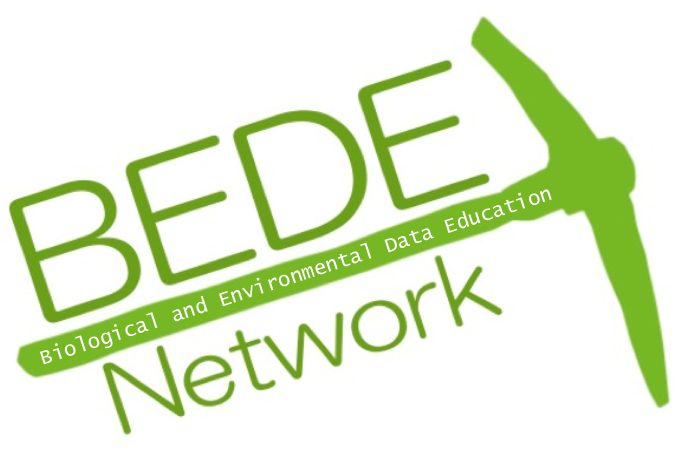Educational Resources
These are some of the exciting classroom activities that have been created by, or recommended by, our BEDE Network members. If you'd like to have your resource featured here, please reach out to Erika: ecrispo@pace.edu.
Three Research-Based Quantitative Reasoning Modules for Introductory Organismal Biology Laboratories
Version: 1.0
We have designed three laboratory modules for an introductory organismal biology course with an emphasis on quantitative reasoning and data analysis skills. Module 1 tests for dimorphism in crayfish chelae using a paired statistical design. Module 2 tests for allometric growth of tapeworm hook structures using a regression model. Module 3 tests for differences in stomatal densities between two groups of plants using a two-sample statistical approach. For all three modules, we emphasize the use of confidence intervals to draw statistical conclusions about hypotheses. Knowledge about the basic biology of animals and plants is required, including arthropods, platyhelminths, and vascular plants. Background reading on dimorphism, allometry, and transpiration provides the necessary foundation to develop questions and hypotheses. Some familiarity with R is necessary for both students and instructors, although the activities can be modified for analysis with Excel or another statistical package. These modules can be taught independently or together as a unit within a course. As stated in the AAAS document, Vision and Change: A Call to Action, the ability to use quantitative reasoning is a core competency that must be developed by all biology students. These modules address the call for instruction in quantitative reasoning and provide a hands-on active introduction to key tools that will be required to build students’ statistical repertoire in more advanced courses.
Primary Image: A highlight of the three modules used in our introductory organismal biology course, including the use of calipers to test for dimorphism in the size of crayfish chelae (upper right), a leaf impression (lower right) from a hydrangea plant (lower left) used to test hypotheses about stomata densities, and the image of an Echinococcus tapeworm (upper left) to test hypotheses about allometry.
Undergraduate education and long-term science literacy are enhanced by integrating data projects with public datasets and creating analysis summaries. Underutilized public datasets are often generated by community-based or citizen science projects to address conservation issues supported by local residents. The objectives of this course activity are for students to contribute to a community science project, observe local species diversity, develop biodiversity questions, and apply data science techniques. Engaging students in these local projects enhances their understanding of the scientific process and its broader impacts on their community. The City Nature Challenge (CNC) is an annual global community science event where students participate by documenting species observations with the iNaturalist application, similar to localized BioBlitz events. Students are guided through using the iNaturalist database to practice biodiversity calculations then data is collected through participation in CNC (or a BioBlitz event an instructor arranges for their class). Spreadsheet software is used by students to organize, analyze, and summarize their relevant data to their peers. Students join the iNaturalist community of observers, which includes professional and non-professional naturalists. Therefore, students can see the themselves as scientists by contributing locally relevant data to a global and digital community of scientists. Experience working with large datasets such as the CNC iNaturalist dataset is essential for STEM careers and building data literacy. Implementing these experiences in classrooms will provide students unique opportunities to learn more about local biodiversity, develop interdisciplinary skills and positively influence a global network of scientists.
Primary image: Students recording biodiversity observations in an open field. At the annual Macaulay Honors College BioBlitz, students are divided into teams to explore a specific NYC park and record the animal and plant life they observed, which they later used to generate biodiversity reports including the species richness and abundances for the park.
Quantifying and Visualizing Campus Tree Phenology
Version: 1.0
Large enrollment courses present a challenge for instructors who want to engage students in authentic science practices that fit the recommendations of Vision & Change. Our lesson provides a meaningful science experience for undergraduates in the context of a large introductory biology course by guiding them to measure seasonal changes of plants on campus. Plant phenology is the study of periodic life cycle events in plants such as bud break, flowering, and leaf senescence. This lesson enables collaborative teams to collect, quantify, and analyze observable seasonal changes in nature. Students collect phenology data on an open-source digital database accessible from their mobile devices. Data are then imported into a simple analytical application hosted by the Quantitative Undergraduate Biology Education and Synthesis Hub (QUBES). Students use the collected data to develop a proposal with questions, hypotheses, and data visualizations. This lesson engages students in authentic inquiry about local and readily observable natural history patterns related to inter- and intraspecific variation in plants and promotes development of observational, quantitative, and communication skills. Our lesson design is highly flexible and suitable across different course levels, course sizes, and college campuses.
